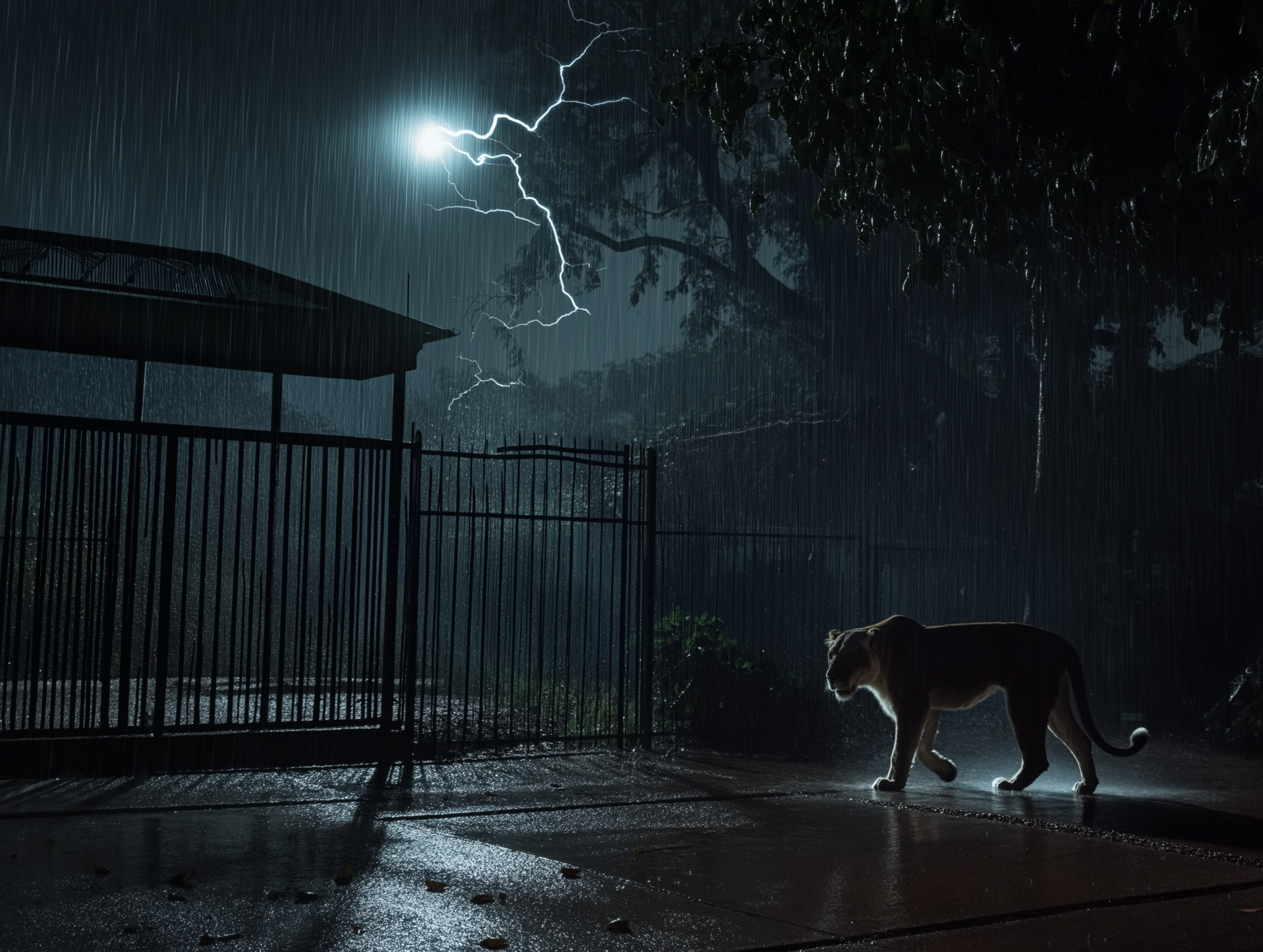The sirens blared as neighbors pressed against their windows, straining for a glimpse. In the middle of Oakridge Avenue, Sahara stood motionless, her golden coat glistening beneath the streetlights. Police rifles aimed steadily, but no one dared move. A child’s voice pierced the silence: “She’s looking right at me.”
Gasps spread as the lion took a step forward, muscles coiled like springs. A reporter’s camera clicked, the sound unnervingly loud in the tense stillness. Parents pulled their children closer. Someone whispered, “It’s over.” Yet Sahara did not pounce. She raised her head, eyes searching for something no one understood.
Tom Reyes broke through the barricade, waving his arms. “Don’t shoot!” he shouted. Every eye turned toward him, the man who had raised the lion from a cub. His voice cracked with urgency, “Please!” The crowd froze, caught between fear and disbelief.
Two nights earlier, Oakridge had slept peacefully under a curtain of rain. At the city zoo, floodlights flickered as winds ripped branches from trees. In the chaos of alarms and scattered staff, a chain-link gate gave way. Sahara, restless and trembling, seized the chance no one had imagined possible.
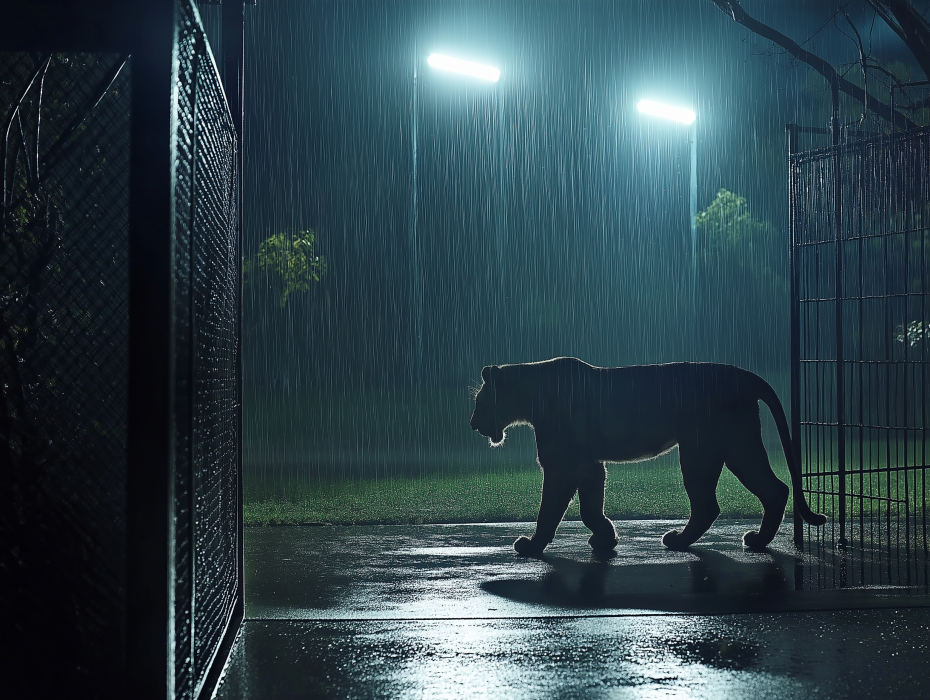
She slipped through puddles and shadows, her lithe frame hugging the ground. Rain masked her scent, drowning the sound of her paws. For the first time since infancy, no bars confined her. The city’s glowing horizon beckoned like a strange constellation. Freedom felt unreal—sharp, frightening, and irresistible all at once.
Back at the zoo, discovery came too late. A night guard spotted the empty enclosure, the trampled mud near the broken gate. Radios crackled, orders shouted: “Lock everything down! Find her before daylight!” But the storm swallowed their voices. Sahara was already gone, carried toward streets she had never known.
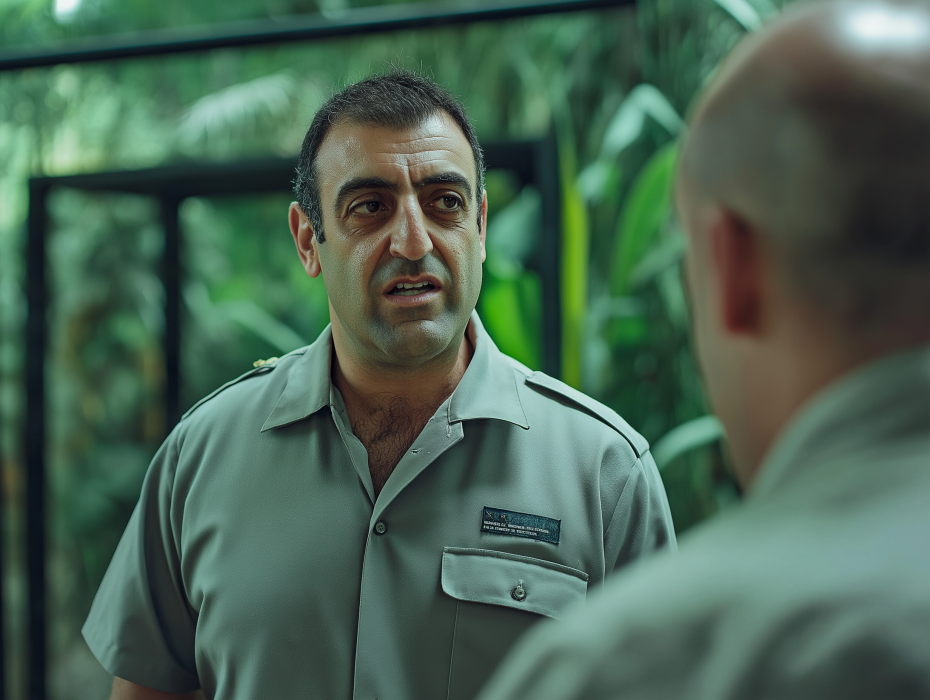
Tom Reyes, her caretaker, heard the news with dread. He had hand-fed Sahara milk as a cub, watched her stumble through her first steps, and soothed her trembling during thunderstorms. He knew her instincts but also her fears. “She won’t hurt anyone,” he told the director. “She’ll be looking for something familiar.”
Morning headlines screamed: LION ESCAPES ZOO. Blurry phone photos showed pawprints on muddy sidewalks. Police cruisers prowled neighborhoods, ordering residents indoors. Schools closed, playgrounds emptied. Fear thickened the air, yet fascination crept alongside. Social feeds buzzed: #FindSahara trended worldwide. Everyone watched. Few understood what truly drove the lion forward.
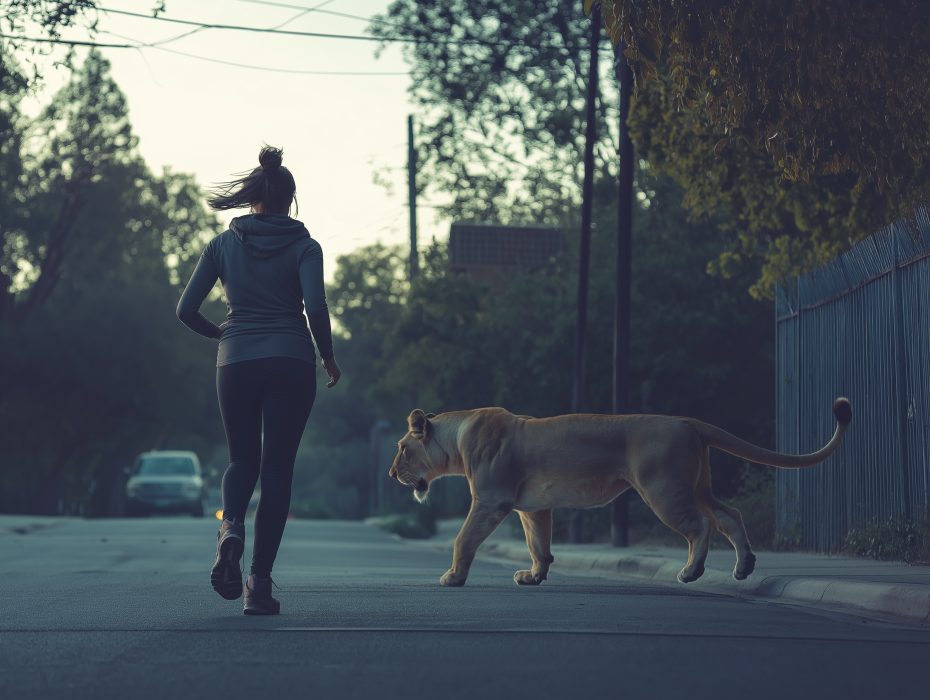
The first real encounter came from Maria Lopez, an early-morning jogger. She slowed near a park bench when her eyes caught movement. A spotted blur streaked between the swings. For seconds, she froze, her chest burning with terror. When Sahara glanced her way, Maria swore her heart stopped beating.
Maria ran, breath tearing, and dialed emergency services with shaking fingers. By the time officers arrived, Sahara was gone. Only pawprints stamped the wet ground. “She was right there,” Maria insisted, voice breaking. The officers exchanged glances, but the report was logged. The city’s pulse quickened with unease.
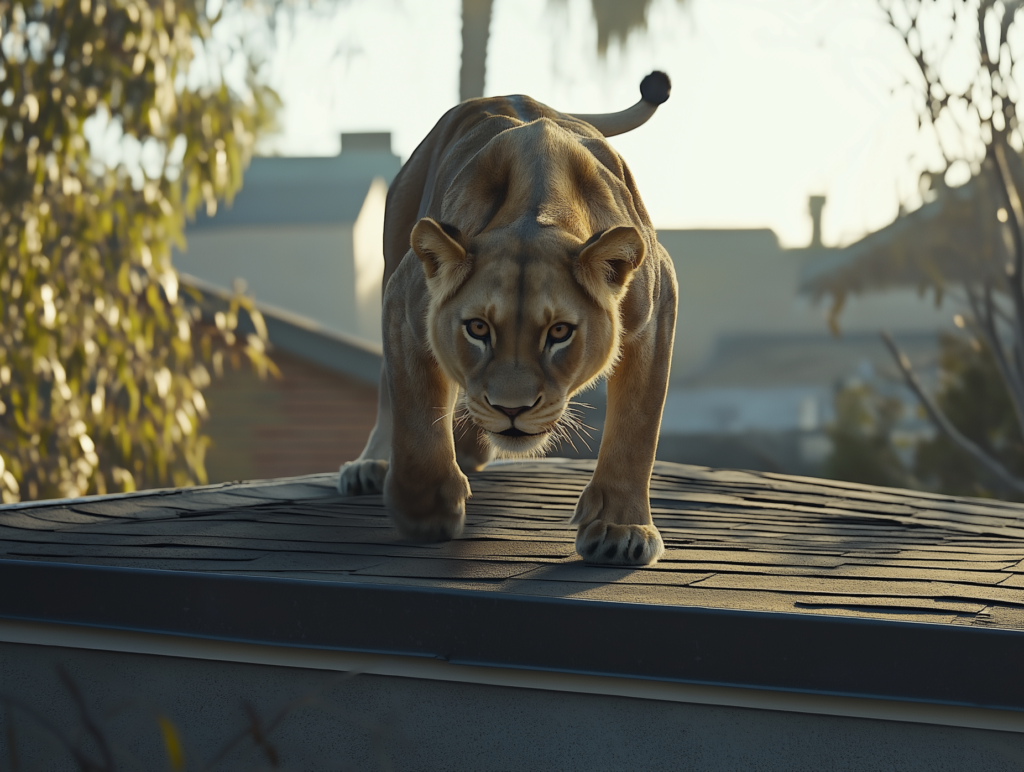
Later that day, a delivery driver parked outside a grocery store. As he returned to his truck, he spotted Sahara on a low rooftop, her tail swaying in rhythm. His heart thudded. He dropped the crate he carried, glass shattering. But he had the sense to click a photo of the cat.
The driver’s photo hit the internet within minutes, a grainy silhouette against a gray sky. Commenters dissected every pixel: Definitely her. Fake—too blurry. Yet the fear was real. Parents checked locks twice, and children whispered lion stories at bedtime. Every shadow seemed alive, every rustle a predator hiding in plain sight.
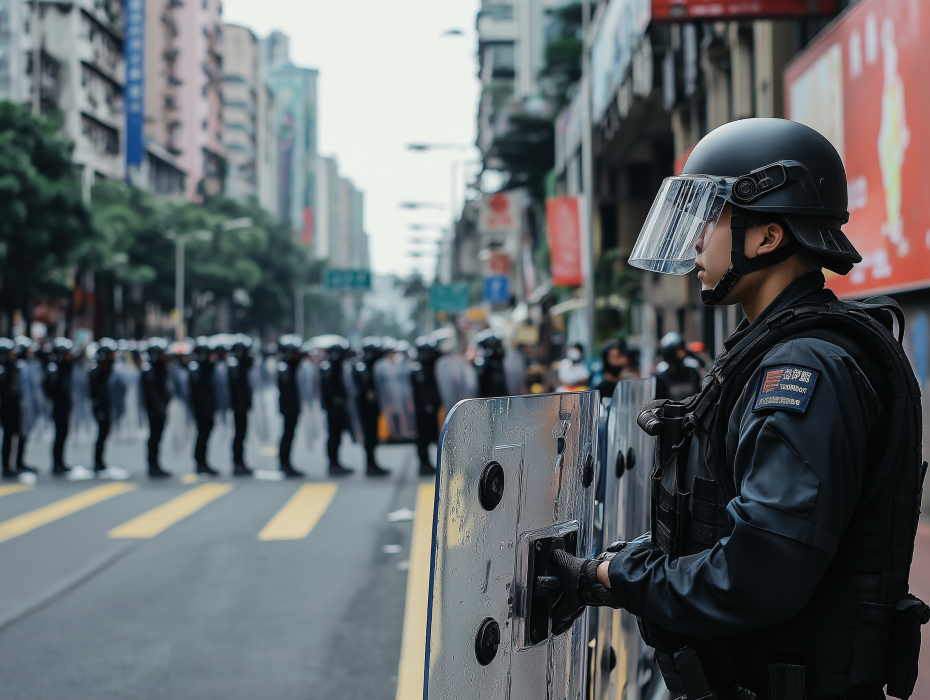
Police doubled patrols, setting up barricades in suspected areas. “We’ll tranquilize her if possible,” the chief assured reporters. “But safety comes first.” Behind closed doors, officers admitted rifles were more reliable than dart guns. Sahara’s fate was already being weighed—not as a living being, but as a potential threat.
Tom Reyes fought to join the search. “She’s not prowling—she’s disoriented,” he told them. “If we give her space, we can bring her back unharmed.” The chief dismissed him. “You’re too close. You can’t see the danger.” Tom clenched his fists, determined. He knew Sahara better than anyone alive.
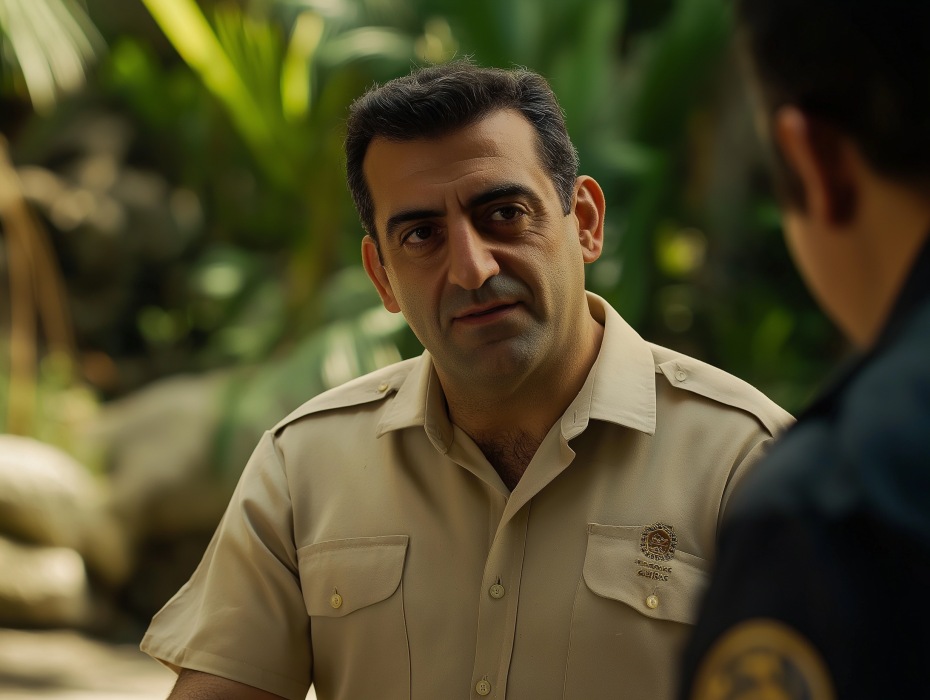
Meanwhile, Sahara pressed deeper into the city. The scents overwhelmed her—oil, trash, fried food, wet concrete. She slipped through alleys unseen, her pace steady, her eyes scanning for something missing. Every sound startled her: honking horns, barking dogs, fireworks crackling in the distance. Still, she pressed on, driven by memory.
A little boy named Ethan glimpsed her from his bedroom window that night. He rubbed his eyes, certain it was a dream. There, under the streetlamp, Sahara paused, her gaze lifting toward the sky. Ethan whispered to his stuffed bear, “She looks sad.” He never told his parents.
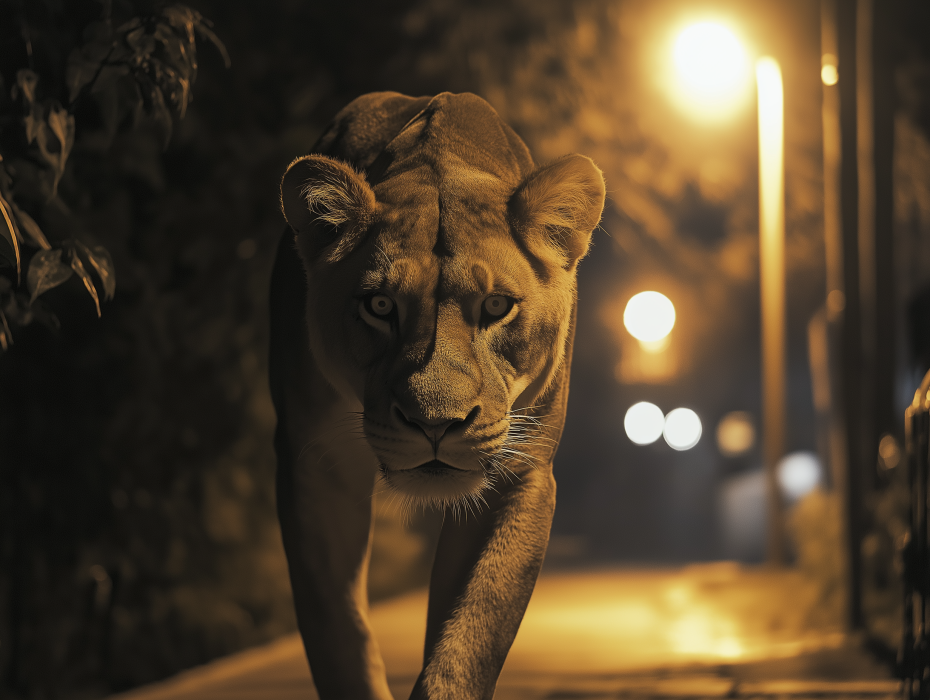
The zoo director faced the press. “We are working with local authorities. The animal is dangerous only if threatened.” His words were crisp, rehearsed, and designed to calm. Yet panic grew. Protests flared online about zoo negligence, about wild creatures behind bars. Some demanded Sahara’s capture, others whispered she deserved freedom.
Tom sat in his apartment, scanning news clips. His eyes lingered on every shaky video. He noticed something most missed: Sahara always paused near sounds from afar—ambulance sirens, faint calls, and low roars carried by the wind. He remembered Nyla, her ailing sister, from whom Sahara had been inseparable. “She’s not escaping,” he murmured.

The revelation burned through him. Nyla had been separated months earlier for treatment in the veterinary wing, too weak for public view. Sahara’s enclosure had faced that wing. Every day, they had seen each other across the fence. Tom’s stomach twisted. “She’s not dangerous,” he whispered. “She’s desperate.”
But desperation colliding with fear could spell tragedy. Police set traps with meat, loaded tranquilizer darts, and primed rifles. Crowds gathered at barricades, whispering prayers and curses alike. And Sahara, unaware of the storm gathering against her, slipped through the maze of human streets, heart hammering with one instinct: find her sibling.
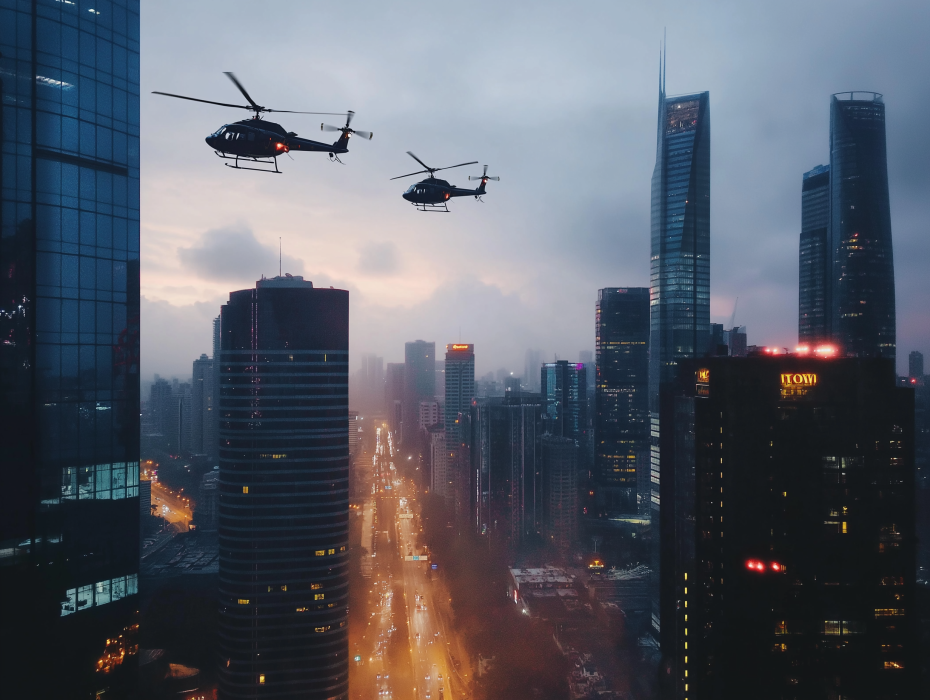
At dawn, helicopters chopped the sky, their searchlights sweeping rooftops and alleys. Residents filmed from balconies, catching fleeting shadows that may or may not have been Sahara. The noise unsettled her, ears twitching with every thunderous blade. She darted into a drainage tunnel, heart pounding, the world vibrating above her.
Inside the tunnel, graffiti and dripping pipes loomed. A pair of workers stumbled across her. They froze, phone cameras raised instinctively. Sahara’s eyes met theirs. Neither screamed. She merely lowered her head, almost shy. The men bolted, their video later sparking millions of terrified views.
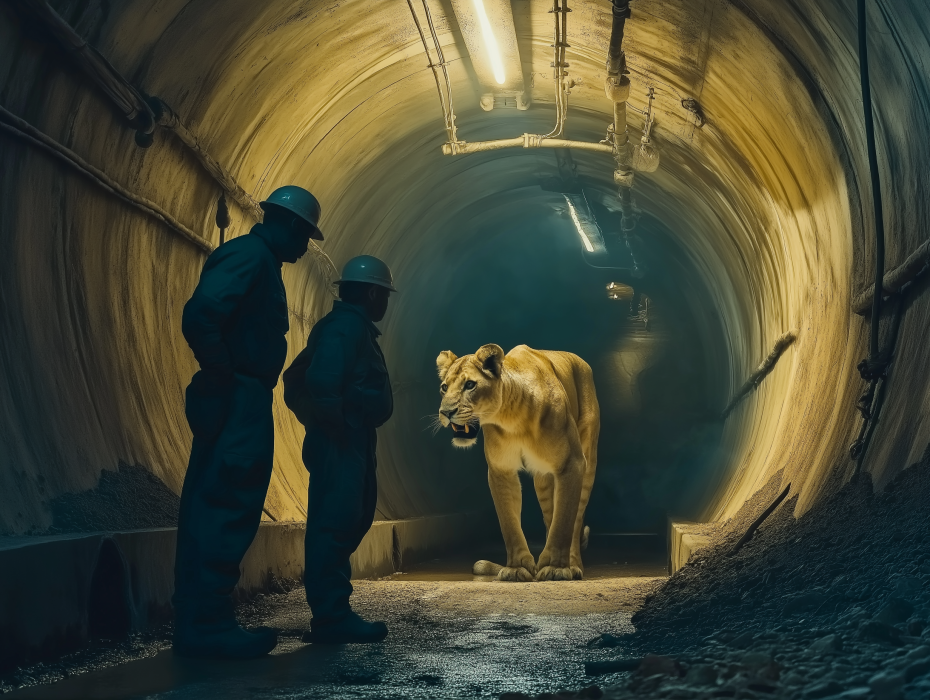
“Dangerous predator stalking the sewers!” screamed the headline hours later. Clips looped on news broadcasts: grainy footage of Sahara’s glowing eyes. Commentators speculated about attacks, though none had happened. Panic bloomed. Every barking pet dog sparked terror, cats vanished indoors, and some families packed suitcases, unwilling to sleep another night in Oakridge.
Tom cursed at the television. “She’s not stalking! She’s hiding from your chaos!” His calls to the police went unanswered, his warnings dismissed. Alone in his apartment, he scrawled on maps, marking sightings like constellations. A pattern emerged—Sahara seemed to be moving in a slow, curving line toward the zoo’s veterinary wing.

Meanwhile, officers combed industrial zones where sightings clustered. One warehouse owner swore she saw Sahara perched atop pallets, staring at the glowing neon sign across the street. The officers laughed, dismissing her account. By the time they bothered to look, only pawprints remained, pressed deeply into the dusty concrete.
Children whispered stories at school the following day. Teachers tried calming their fears, but curiosity spread faster. “Did you see the video?” one boy whispered. “Her eyes glow like fire.” A girl whispered back, “She’s dangerous.” Rumors spun until Sahara became half-monster, half-myth—every shadow a possible predator.

That evening, an elderly woman named Mrs. Latham was taking trash to her bins when she noticed Sahara crouched by her rose bushes. The lion sniffed about and then looked up. Mrs. Latham froze, then whispered softly, “You’re beautiful.” Sahara blinked, then vanished over the fence. The old woman never reported it.
The city wasn’t so forgiving. News spread of “an attempted backyard attack.” Police amplified warnings, urging people to keep themselves and pets indoors. Reporters framed Sahara as a menace, a ticking clock. Yet whispers of Mrs. Latham’s quiet story drifted through the neighborhood, contradicting the official narrative. Sahara wasn’t killing, only passing through.
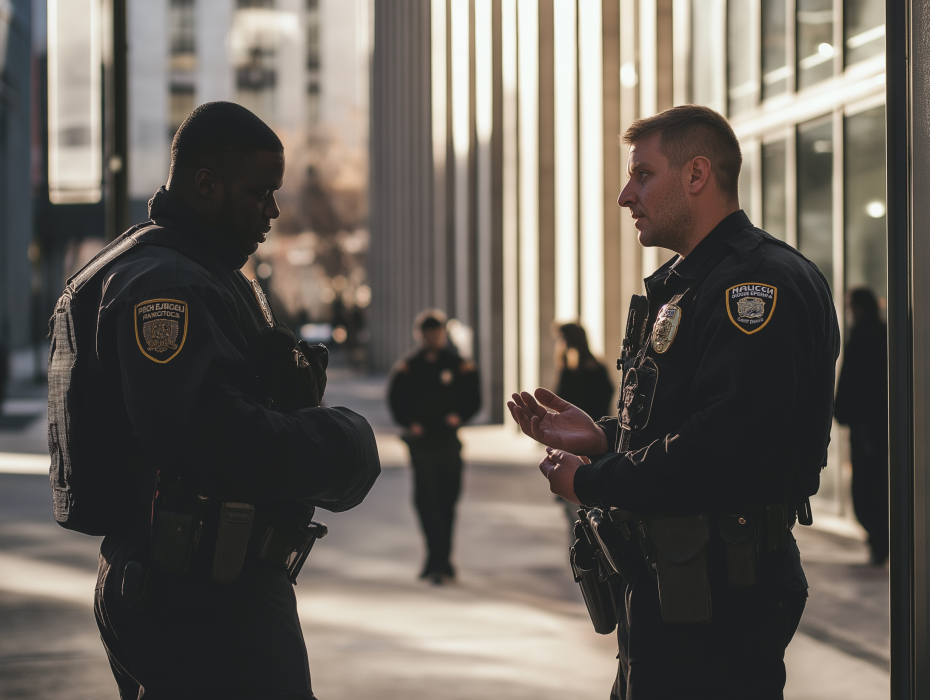
Desperation hardened the authorities’ stance. “Next encounter, we fire if necessary,” declared the chief. Patrols doubled, rifles locked and loaded. Fear tipped toward violence. Yet Tom’s gut twisted—every decision pushed Sahara closer to a forced encounter. He scribbled one word across his maps, circling it again and again: Nyla.
Nyla’s condition worsened in the zoo’s medical wing. Thin, frail, she lay curled in her pen, occasionally lifting her head as if listening. Keepers tended her with caution, unaware that Sahara prowled the city, inching ever closer. The bond between them pulsed invisible threads, a tether guiding Sahara homeward.
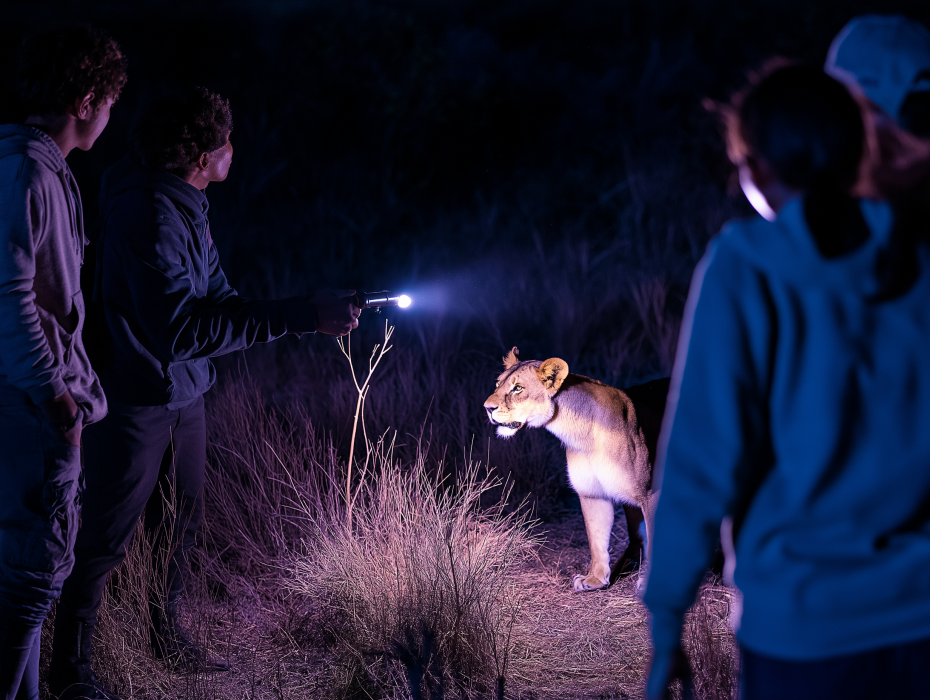
In Oakridge Park, a group of youngsters gathered for a late-night dare: to spot Sahara. They whispered nervously, flashlights slicing the dark. Suddenly, she appeared, emerging from the treeline like a phantom. The boys froze. One dropped his soda can, the clatter echoing. Sahara flinched, then bounded back into the shadows.
The encounter reached the news within hours. “Lion Stalks Park!” blared anchors. The truth—that Sahara had been startled, and was not aggressive—was buried. Police swarmed the park, rifles drawn. Families in surrounding blocks were evacuated. Yet Sahara was already blocks away, slipping silently down residential streets where porch lights blinked nervously on.

Tom knew that things couldn’t be left as it was. A vague idea was taking shape in his mind. But he also knew that it would face backlash from the director and the zoo authorities. They would hardly be willing to listen to him, especially when the stakes were so high. He decided to wait until he could frame a more concrete plan.
Meanwhile, fear shifted into obsession. Amateur hunters loaded trucks, scouring back roads without legal permission, hoping for glory. Others followed with cameras, live-streaming shaky footage, hunting likes, instead of the lion. Sahara eluded all. She stayed just ahead, her path precise, her instincts guiding her steadily back toward the zoo.
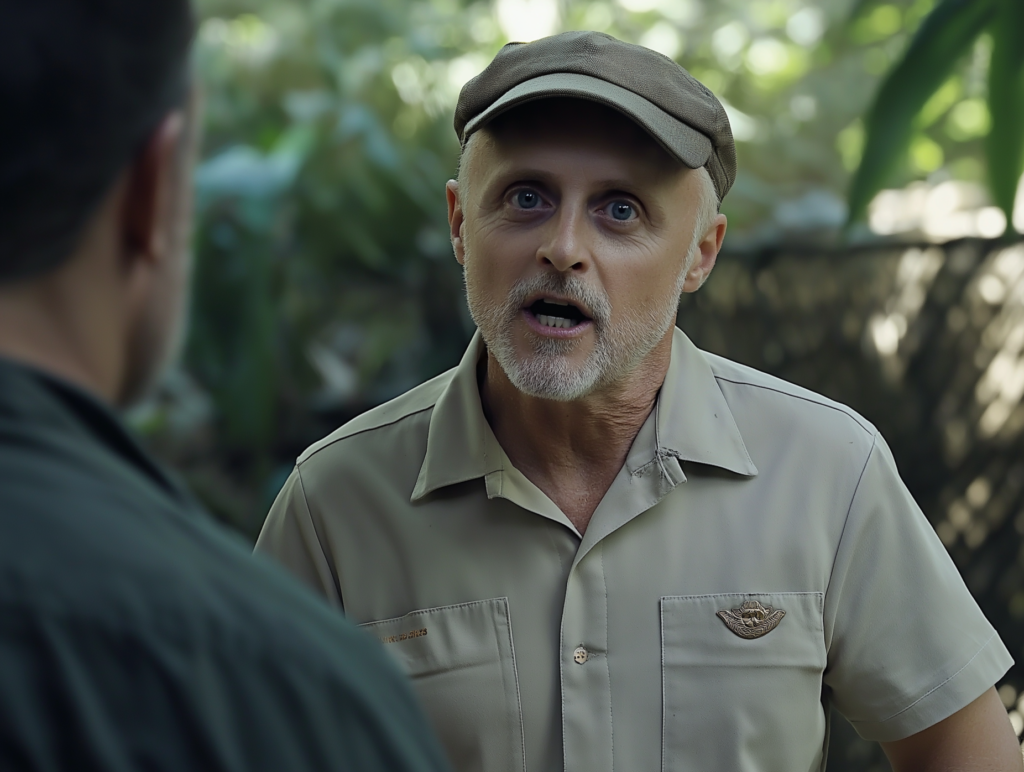
Tom finally forced a meeting with the director. “You don’t understand—she’s trying to come back. She’s not hunting, she’s homing.” The director waved him off. “We can’t gamble lives on your sentiment.” Tom slammed the table. “It’s not sentiment—it’s fact. If you shoot her, you’re killing the bond that might save her and Nyla.”
By now, the city buzzed with sightings almost hourly: Sahara slipping between dumpsters, Sahara sprinting across a soccer field, Sahara vanishing through alleys faster than cameras could focus. Each report blurred fact and fiction until she became less an animal, more a phantom haunting Oakridge’s imagination.
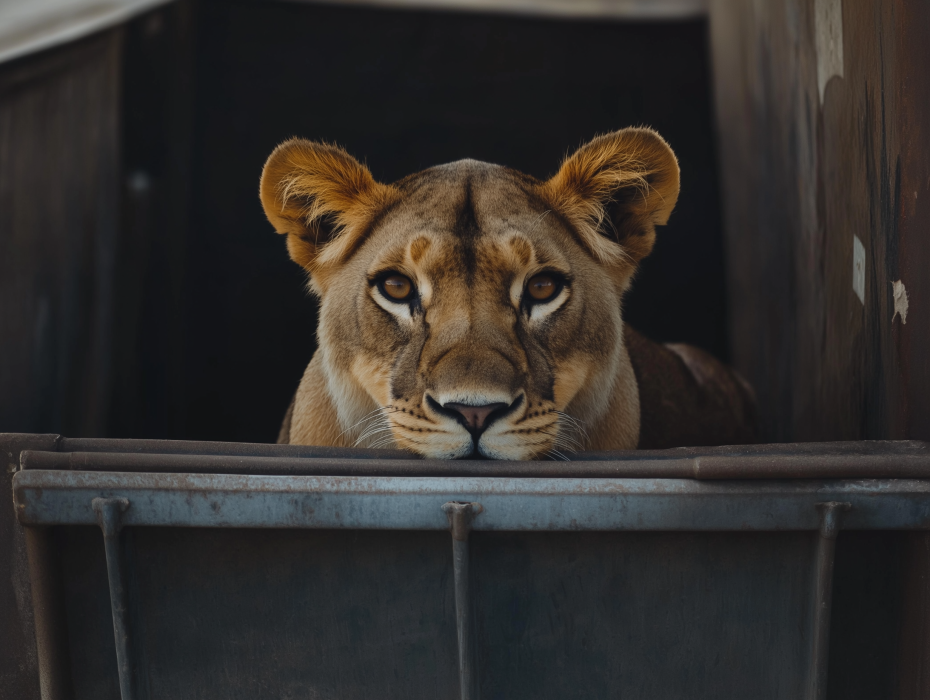
Tom worked on a plan to lure Sahara to a spot discreetly where the zoo authorities could capture her without a threat to the safety of the public. The main problem was that the minute anyone spotted the lion, it would turn the whole event into a media circus, increasing the chances of someone getting hurt!
Authorities raised the stakes: a $10,000 reward for tips leading to capture. Suddenly, everyone became a hunter. Calls flooded dispatch, most false ones, clogging the lines. The chief grumbled, “We’ll be set back by days, at this rate.” Yet Sahara always slipped away, too swift for bullets, too clever for traps, driven by something deeper.
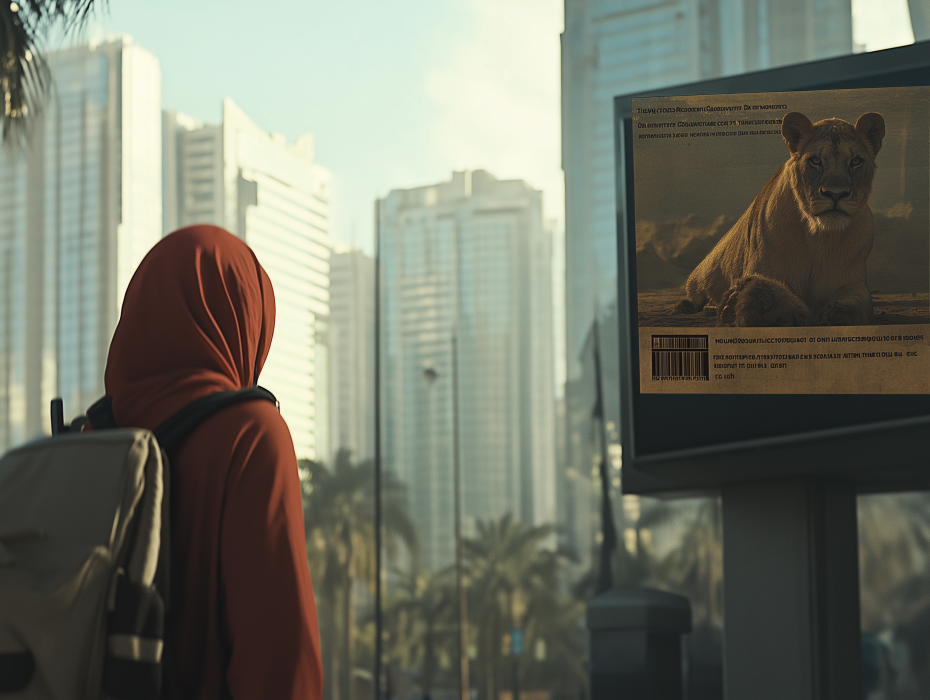
Tom traced her sightings on the map again. The arc was unmistakable: Sahara was circling back, closer each night, orbit tightening toward the zoo. “She’s not lost,” he muttered. “She’s coming home.” But the city didn’t see patterns. And every barricade narrowed the path to tragedy.
Rain slicked the streets as Sahara padded across an overpass, traffic roaring below. Horns blared, brakes screeched, and drivers swore at the phantom streak. A video went viral within minutes: Lion Above the Highway. Fear swelled—if she could cross highways, nowhere in the city felt safe anymore.
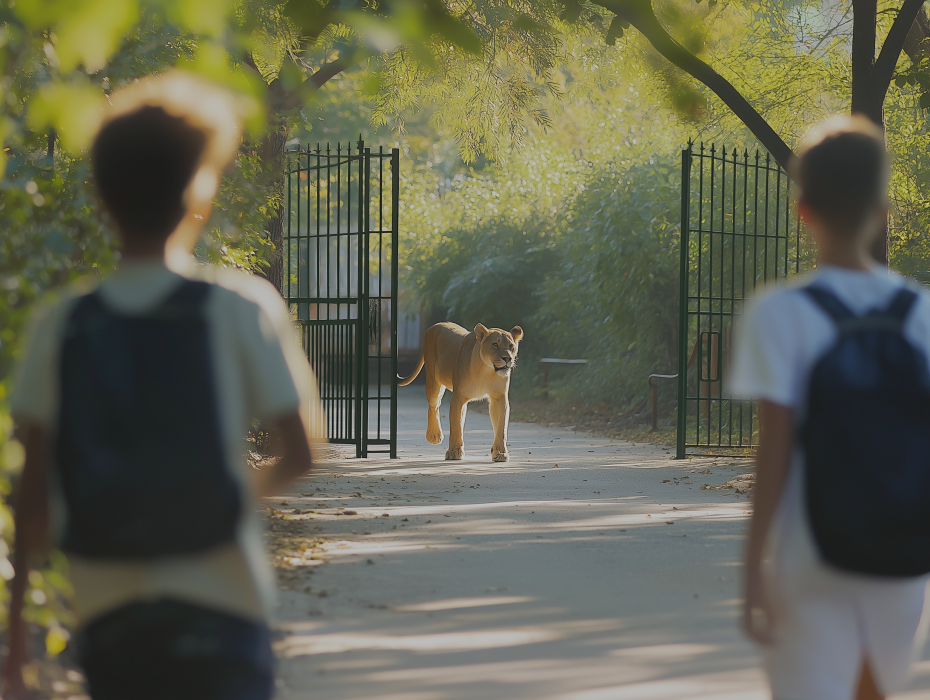
Some teenagers, emboldened by online dares, left raw chicken in the park to lure her. Cameras rolled as Sahara emerged from the shadows. Instead of eating, she sniffed the meat and stepped past it, scanning the horizon. The teens fled screaming anyway, their video racking millions of horrified views overnight.
Police seized on the footage. “Predatory behavior,” the chief declared. “She’s testing boundaries.” Officers stationed sharpshooters near schools and playgrounds. Parents protested, outraged that their children lived in a militarized neighborhood. But fear drowned reason—every creak of branches became claws in the dark.
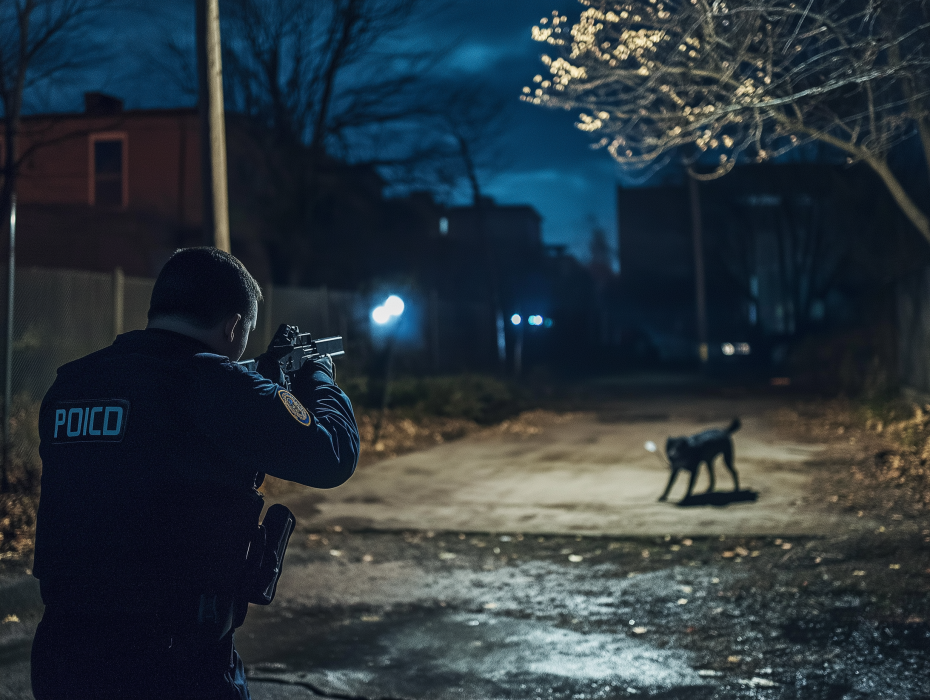
One such mistake nearly ended tragically. An officer fired at movement in a vacant lot in the early hours of dawn, only to strike a stray husky. Outrage exploded online—They’ll kill anything with fur! The chief insisted protocol had been followed. But the line between precaution and recklessness grew thinner by the hour.
Tom marked another pin on his map. The pattern confirmed a path unmistakably toward the zoo. “She’s coming back,” he whispered, fingers trembling. But city officials dismissed him again. “Wishful thinking,” the chief scoffed. “She’s prowling for prey.” Tom bit back his rage, knowing Sahara’s hunger wasn’t for meat—it was for family.

After much thought, Tom decided the only way that could work might be to lure Sahara with Nyla’s scent. The cat that wouldn’t fall for food bait must surely respond to the pull of blood tie. The only big hurdle that remained was to convince the authorities and plan the details.
Tom spent sleepless nights sketching maps, tracing Sahara’s movements like constellations. His plan became his obsession: to guide her back with scent, voice, and memory. Nyla’s blanket would be placed at the vet wing, the gate left open, and Tom himself would stand as the beacon. There would be no need for rifles, he hoped.
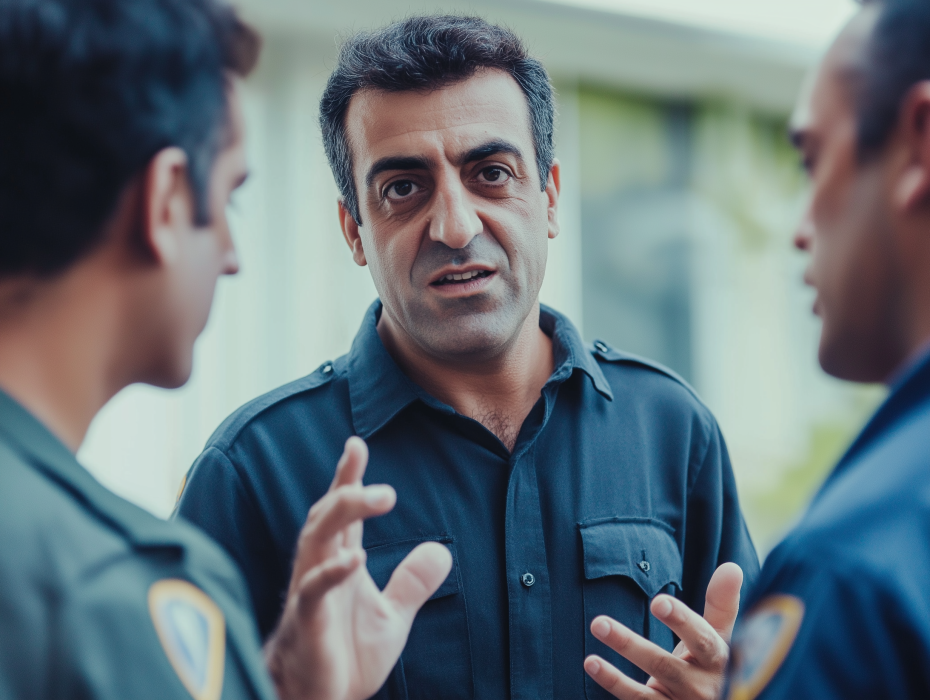
The police scoffed at first. “One wrong step and she kills someone.” Tom pushed back, his voice cracking. “She won’t attack—she’s searching. I can bring her home.” Against resistance, he won a fragile agreement: one corridor sealed by vehicles, the crowd pushed back, tranquilizer darts kept ready only as a last resort.
Tom visited the vet wing. Nyla lay weak in her pen, breathing shallow, ribs visible beneath her coat. She lifted her head faintly at his voice. “She’s coming for you,” Tom whispered, heartbroken. The keepers gave him everything he asked for. Determination blazed in his chest.
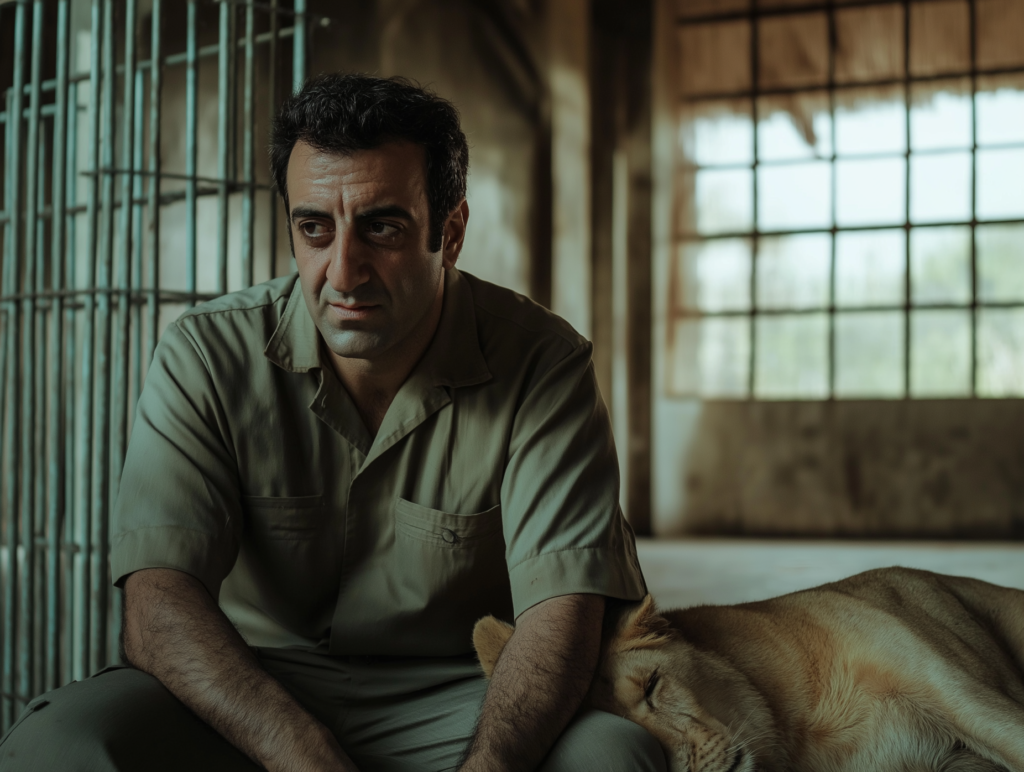
Meanwhile, Sahara’s hunger gnawed at her. She prowled dumpsters, ripping into trash bags, swallowing spoiled scraps. A neighbor filmed from his window, disgusted: “She’s hunting near children!” Yet the footage betrayed her weakness—her ribs were showing, movements slower, nothing like the predator described. She was surviving, not hunting.
Amateur hunters still prowled alleys with crossbows and rifles, chasing rumors for glory. One group nearly cornered Sahara behind a warehouse. They raised their weapons, but her speed burst through the gap before they fired. Only claw marks on the wall remained, mocking their failure. She became a ghost and a legend, untouchable.
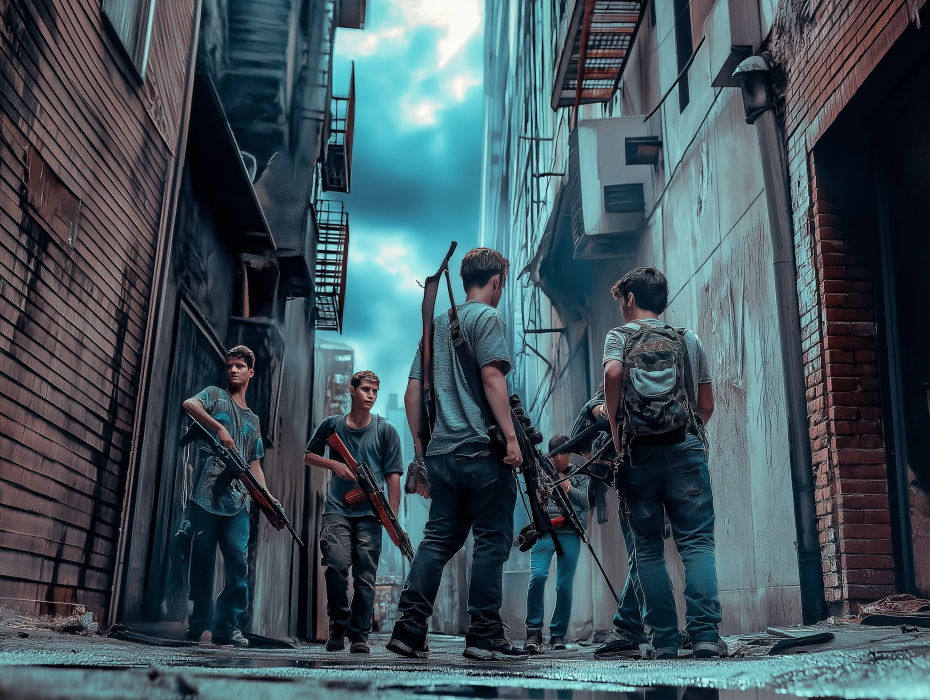
Authorities escalated: “Tranquilizers won’t work—too risky.” Snipers were ordered to fire on sight. The public split—some demanded blood, others begged for mercy. Talk show hosts and guests shouted over each other: Predator or prisoner? Sahara, unaware of debates raging in living rooms, limped quietly closer to the only home she knew.
Near dawn, officers cornered her in a shipping yard. Spotlights flared, engines revved, rifles lifted. A dart whizzed past, grazing her shoulder. Sahara bolted, leaping fences with impossible grace, though her stride faltered. The crowd watching believed she’d attacked someone. “Aggressive!” headlines screamed. In truth, she fled, wounded and terrified.

Tom punched the wall when he heard. “She’s hurt, and now you’ll call it proof!” His pleas went ignored. To the city, Sahara was no longer a lion—she was a headline, danger, and a spectacle. But Tom saw the truth: she and the city was running out of time.
The near-capture deepened hysteria. Some residents left town altogether, convinced disaster was inevitable. Others flocked closer, determined to witness the unfolding drama. Crowds gathered at barricades, smartphones ready. Sahara became Oakridge’s reluctant star, her every step broadcast, analyzed, sensationalized. Humanity’s theater tightened around her.

On the appointed day of the attempted capture, Oakridge hushed. Floodlights framed the narrow route, police radios hissed, and cameras bristled at the barricades. Tom stepped into the open, heart pounding, carrying the cloth that carried Nyla’s scent. He called softly, a sound barely audible. Sahara appeared after what seemed like an age, ribs showing, eyes fixed.
Every step she took was deliberate, slow, guided by a scent trail perceptible to none but her. The crowd murmured, hushed into reverence. Nyla’s faint recorded moan echoed, carrying across the night. Sahara froze, ears pricked, then answered—weak, trembling. Tom’s chest clenched. She was nearly home.
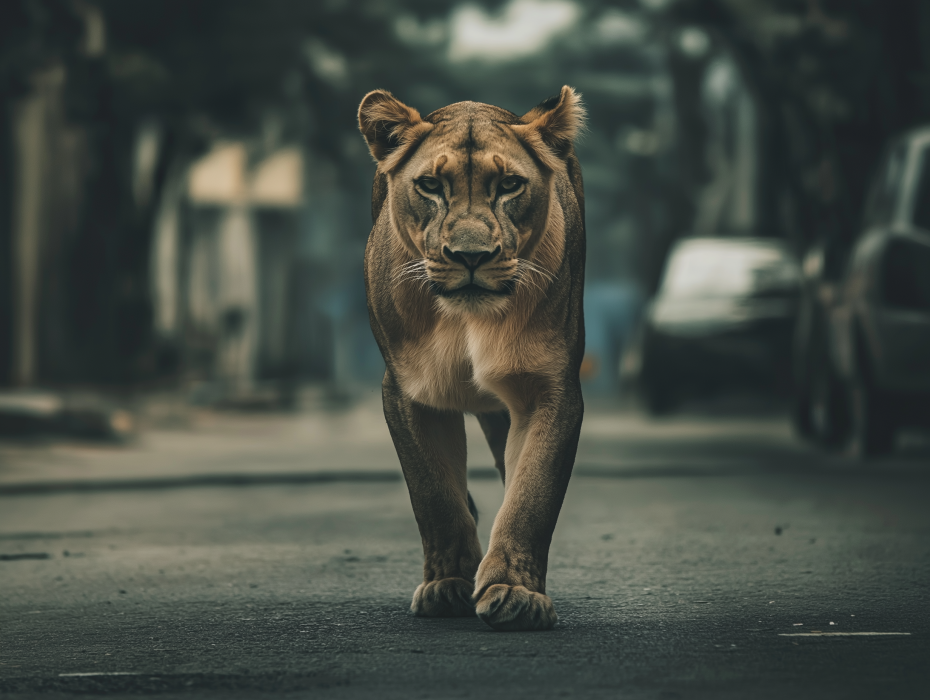
Keepers silently swung the gate open, and for one fragile moment, hope bloomed. Sahara limped forward, her tail twitching, eyes locked on the destination. Tom held his breath, urging her on with whispered encouragement. Even the officers seemed struck, fingers hovering but still, waiting for what might be a miracle.
Then a shout shattered the night. A freelance cameraman had crawled too close, desperate for a shot. His camera slipped from his hands, crashing against metal with a hollow clang. Sahara flinched violently, muscles spasming. She spun, bolting sideways toward a narrow lane that led to the next junction. Tom cursed at the missed opportunity.
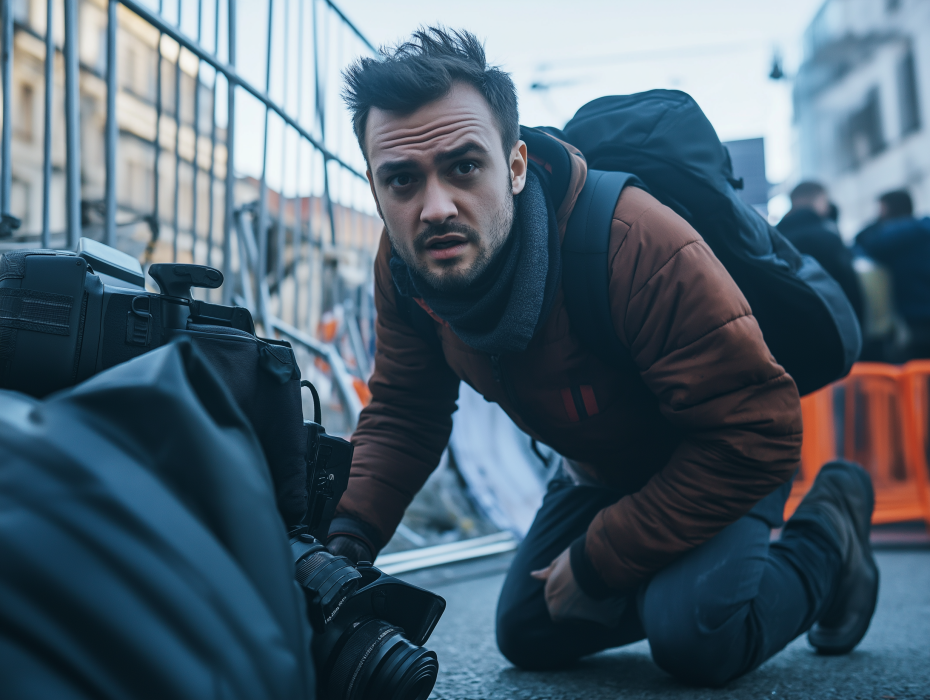
The same night, a news helicopter spotlight found her on a nearby terrace, limping, breath ragged. The camera zoomed in, transmitting her exhaustion worldwide. For a fleeting second, millions saw Sahara more as a prisoner than a predator. Then she leapt away, vanishing again, leaving the city gasping.
Tom’s desperation boiled. He stormed the police barricade, demanding to be heard. “She’s heading for Nyla—you’re driving her into your crosshairs!” Officers dragged him away. Reporters caught his outburst, headlines twisting it: Zookeeper Blames Police For Escaped Lion. But his resolve hardened. He alone understood her path.
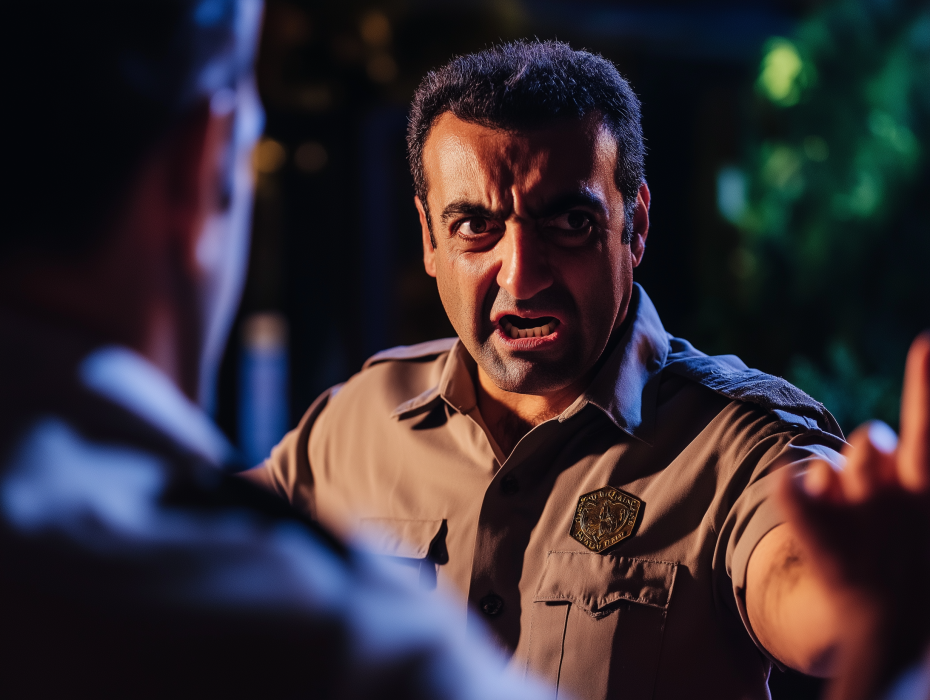
The countdown was imminent. Sahara’s line tightened, each step pulling her toward the zoo’s perimeter. Crowds multiplied, barricades strained, rifles gleamed under floodlights. The city braced for the inevitable. And Tom knew: when she reached Nyla, the standoff could explode.
Floodlights lit the zoo’s perimeter as police, reporters, and curious onlookers pressed against barricades. Rumors spread quickly that Sahara had been spotted only blocks away. Snipers climbed rooftops, tranquilizer teams flanked entrances. The air thickened with anticipation. Everyone waited, phones raised. The city was holding its breath.
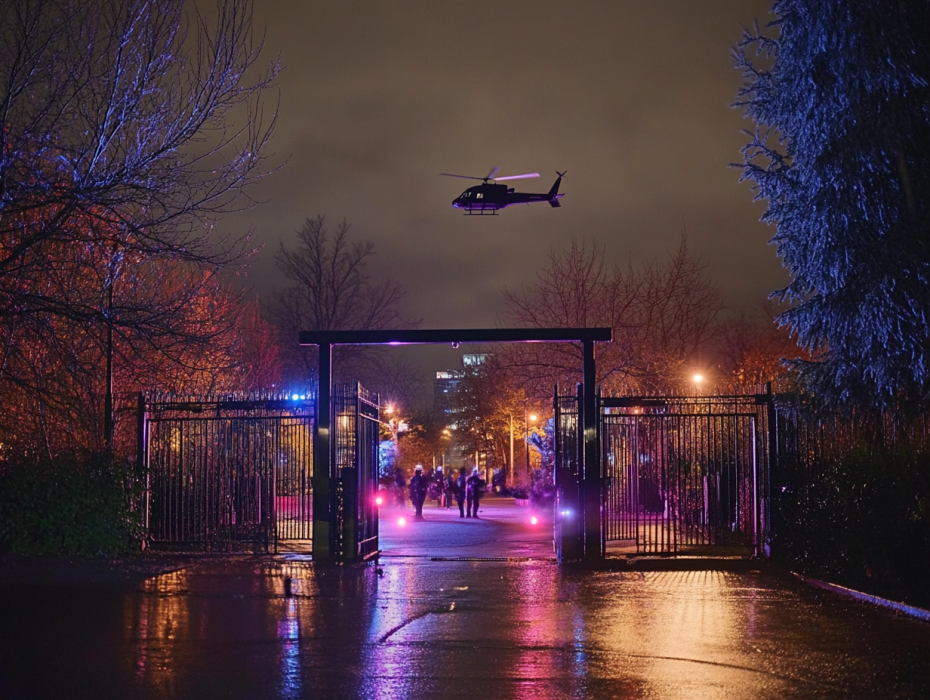
Sahara slunk through the shadows, paws aching, shoulder burning where the dart grazed her. She paused to breathe, nostrils twitching at a faint, familiar scent. Her eyes narrowed, muscles tightening. She was close. Closer than she had ever been. Nyla’s scent was strong. She pressed forward.
Everyone knew what happened next would be vital. A tranquilizer shot would take some time to take effect, in which time, Sahara could hurt someone accidentally. Besides, in Sahara’s emaciated condition, too much of the drug could trigger a cardiac arrest. Shooting could only be a last resort.
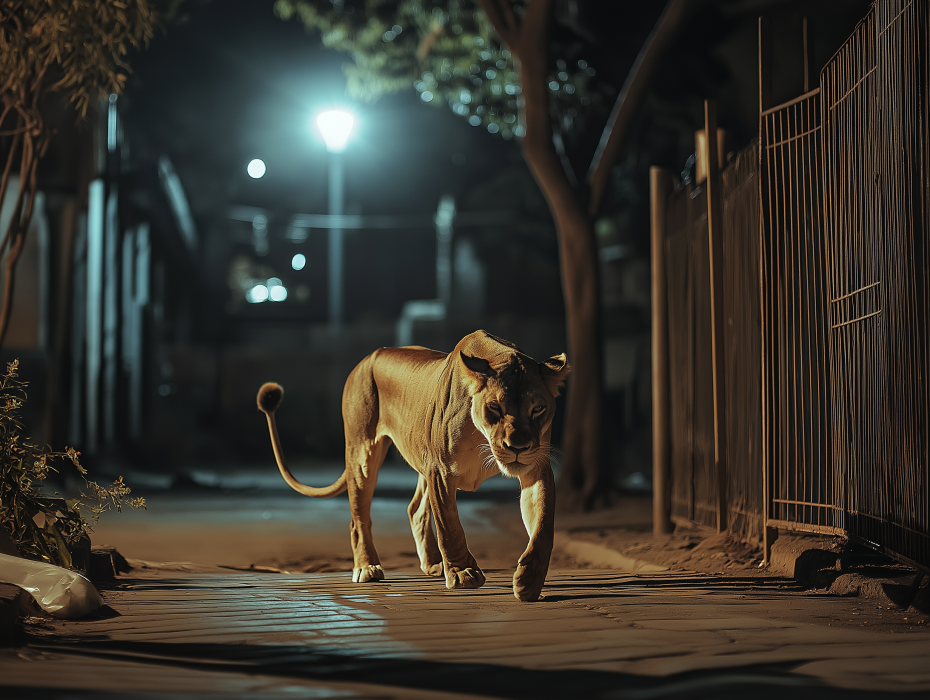
The first glimpse of the absconding cat came from a teenager livestreaming on his phone. Sahara slipped under a streetlamp, fur shimmering gold. Gasps rippled through the crowd. “There! There she is!” The police raised their weapons instantly. The crowd screamed in unison—half pleading for mercy, half chanting for action. The standoff had begun.
Sahara paused on Oakridge Avenue, framed in the harsh glow of floodlights. She looked neither left nor right, only forward, as if seeing something no one else could. Police rifles tracked her every step. The crowd swayed, torn between awe and terror. The city’s predator had come home.
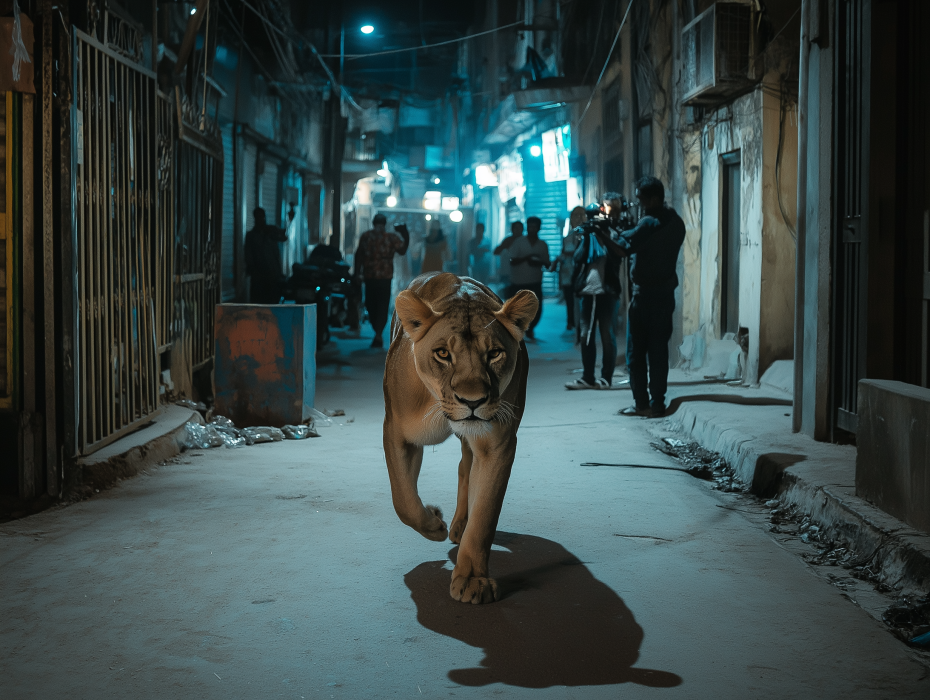
Gasps erupted when Sahara stepped forward. Cameras clicked, flashes exploding like lightning. Parents dragged their children back, sobbing. Officers shifted their aim, fingers tightening. “Hold your fire!” one shouted, but nerves frayed. Every second stretched taut, a fragile thread threatening to snap. Sahara’s shadow lengthened under the blazing lights.
Tom broke through the barricade, shoving past officers. His voice cracked as he screamed, “Don’t shoot!” He waved his arms wildly, drawing every gaze. “Please, she’s not attacking—she’s searching!” The crowd roared in protest, police lunged to restrain him, but Tom stood firm, planting himself between rifles and the lion.
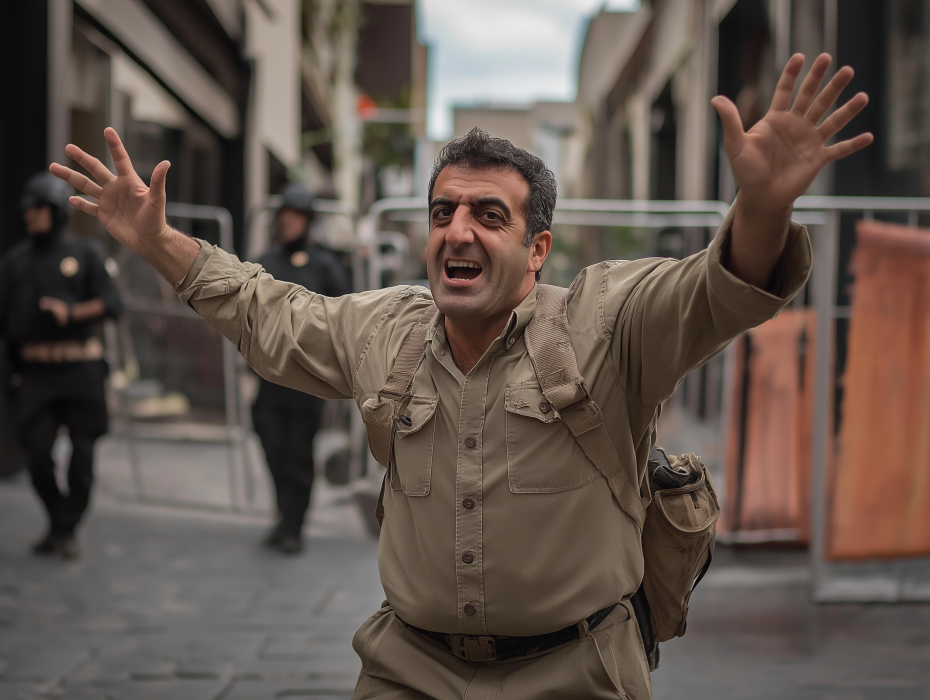
The chief snarled into his radio, “Get him out of there!” But Tom’s eyes never left Sahara. He saw her trembling legs, the wound on her shoulder, the desperation in her stare. “She wants her sister,” he shouted. “If you kill her now, you’re killing the bond that brought her back.”
Sahara lowered her head, ears flicking, muscles quivering like taut wires. She took another step forward, tail sweeping. A rifle clicked audibly. The crowd shrieked. Tom raised his arms higher, chest heaving. “Please—she’s not a monster. Give her a chance!” His plea echoed, raw against the metallic hum of weapons.
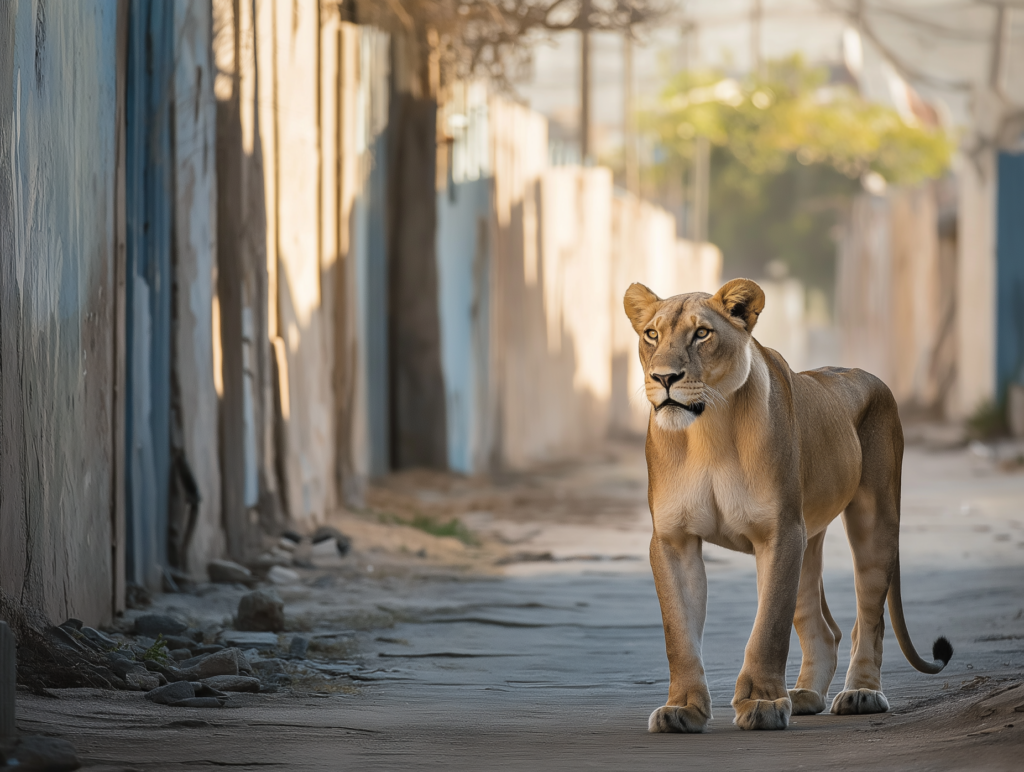
Then it happened—Nyla’s faint call from inside the vet wing, weak but unmistakable. A soft, rasping moan only lions make to one another. Sahara froze, ears twisting sharply toward the sound. Her entire body shuddered, torn between fear of the rifles and the pull of blood calling her home.
The crowd fell utterly silent. Even reporters lowered their cameras. Sahara’s gaze softened, shifting from the barricade to the distant veterinary wing. She moaned back—short, urgent, heartbreaking. The two sounds pierced through noise and fear, carrying something primal. “She hears her,” Tom whispered. “She’s not hunting. She’s going home.”
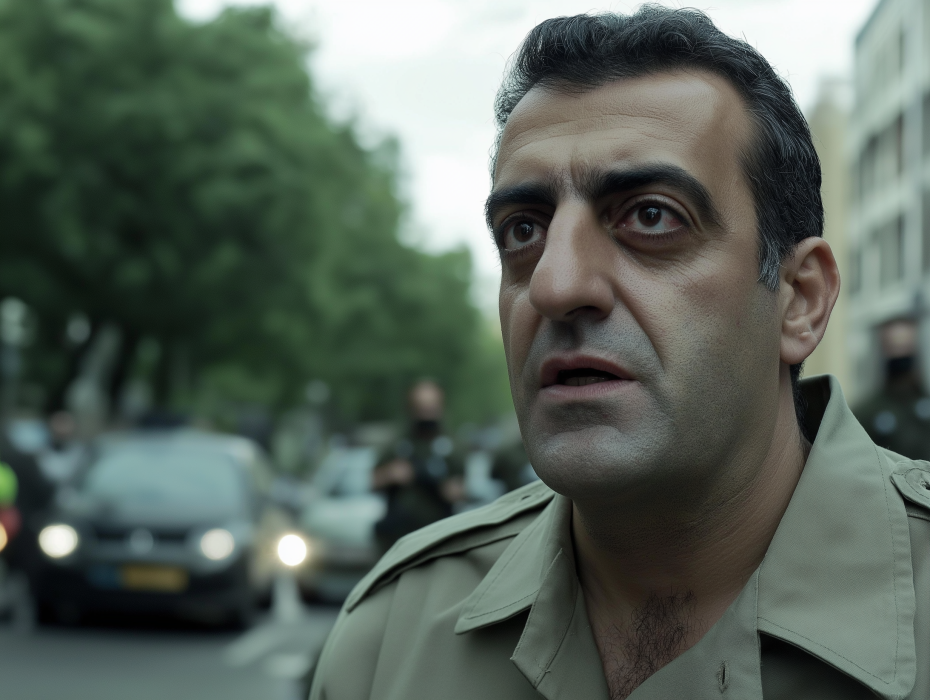
Tears stung Tom’s eyes as Sahara moved again, slow and deliberate. Every rifle tracked her. Every breath in the crowd hitched. A single shot could end it all. Yet Sahara didn’t lunge or pounce. She walked—wounded, limping, but steady—drawn only by the faint voice of her sister.
The chief barked, “She’s breaching perimeter—take the shot!” Fingers tightened on triggers. Tom spun, shouting desperately, “If you shoot, you’ll kill both of them—don’t you see?” His words cracked with desperation. For a moment, the rifles wavered. The city’s fate teetered on seconds of human restraint.
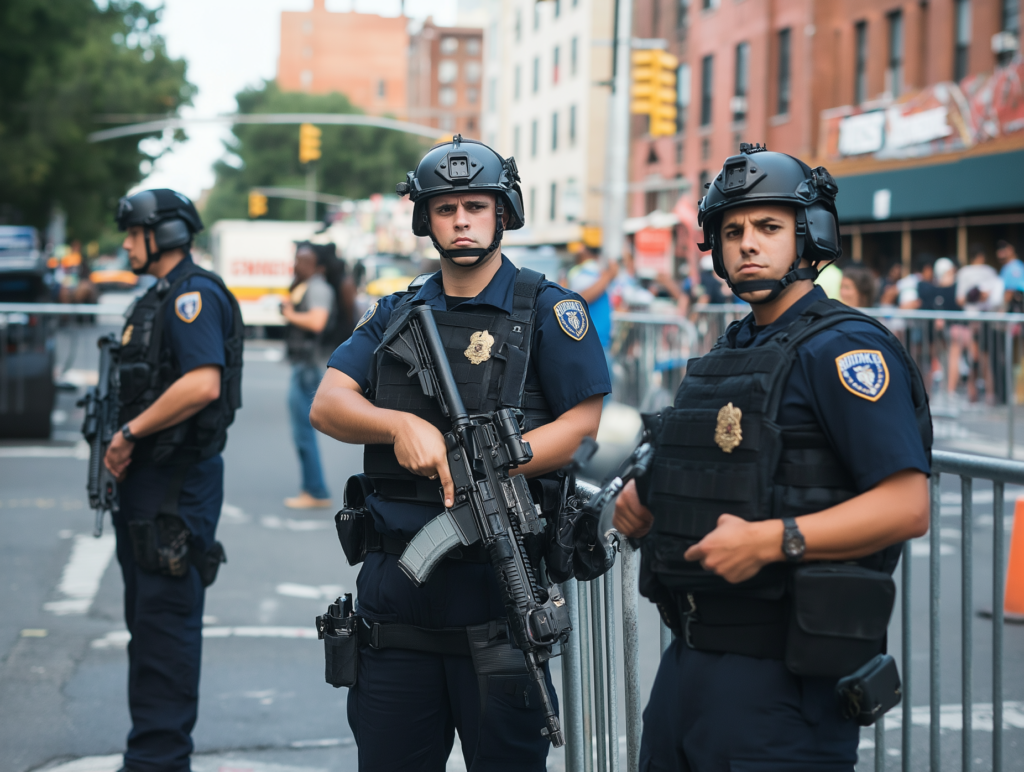
And then Sahara stopped, raising her head high. The crowd gasped as her gaze swept across them—predator, prisoner, sister, and survivor. She released a low, haunting moan that carried through the floodlit night. For that suspended moment, even rifles lowered slightly, held by something larger than fear: recognition.
The standoff broke when Nyla’s cry sounded again, faint but unyielding. Sahara turned fully toward the vet wing, ignoring rifles, cameras, and fear. The crowd held its breath. At last, the chief lowered his hand. “Stand down,” he muttered. Weapons wavered, disbelief rippling. Against every order, mercy held.
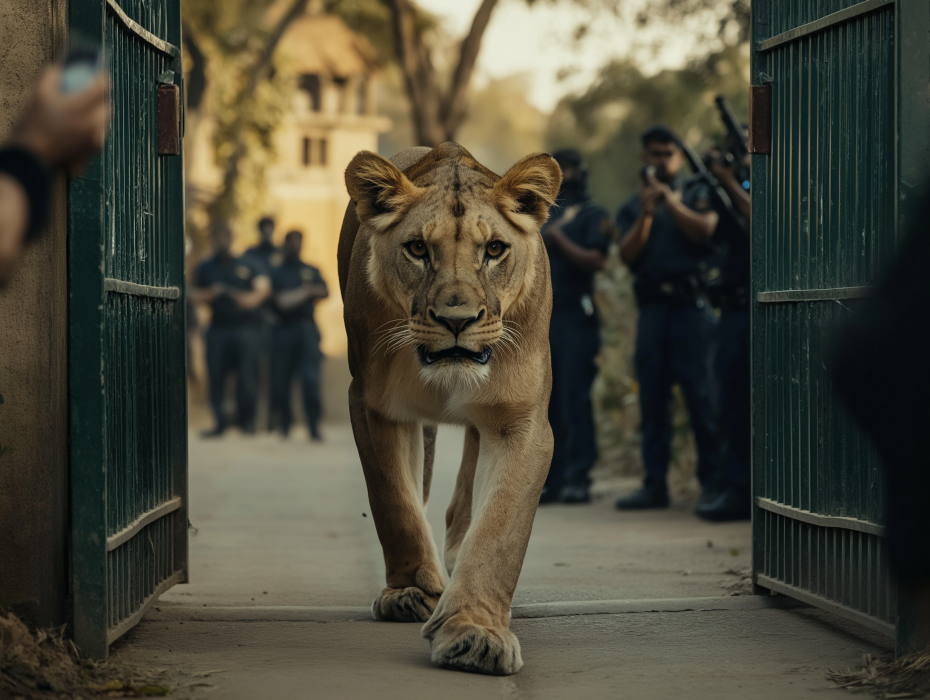
Keepers cracked open the gate to the medical wing, hearts pounding. Sahara slipped through, limping, eyes locked forward. Inside, Nyla stirred weakly, ears twitching. The sisters’ eyes met, and Sahara moaned again—soft, trembling. Nyla answered, the faintest echo of life. The reunion silenced Oakridge more deeply than rifles ever could.
Reporters whispered frantically into cameras, unsure how to frame what they had seen. A predator reunited with its kin? A city frozen between fear and awe? The footage replayed worldwide within minutes, but the truth escaped easy headlines. Something sacred had unfolded in the floodlights—something beyond spectacle.
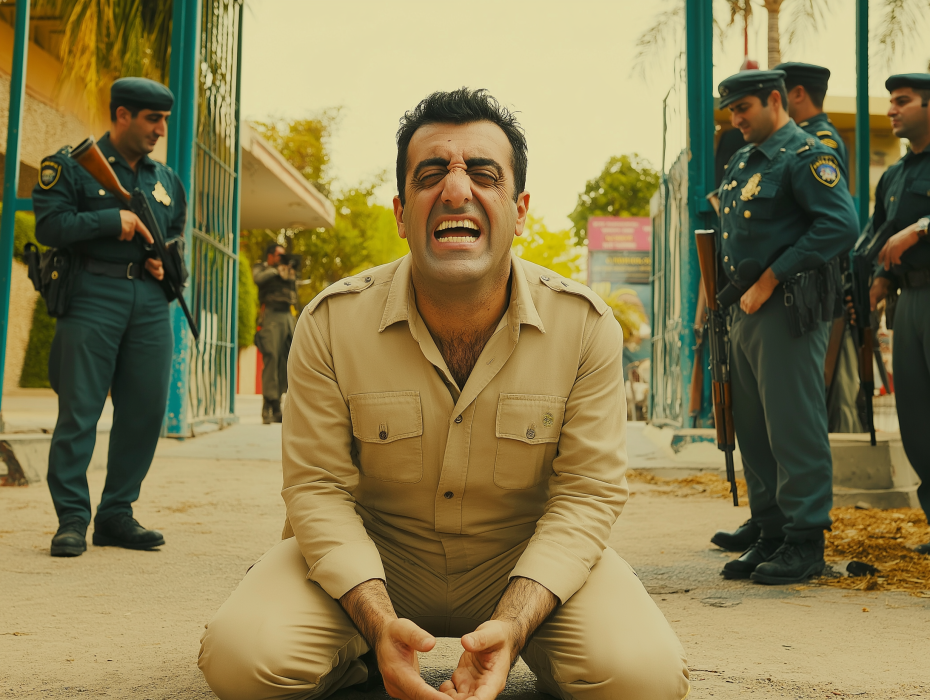
Tom knelt by the gate, tears streaming. “She came home,” he whispered, voice shaking. Around him, officers shifted awkwardly, rifles slack. The crowd, once brimming with terror, now hummed with reverence. Sahara pressed her face gently against Nyla’s through the bars, breathing in the only comfort she had ever known.
In the days that followed, the city softened. Critics demanded accountability from the zoo; others lobbied for a sanctuary where both sisters might heal together. Children sketched lions not as monsters but as guardians. Oakridge’s narrative had changed to one of survival and kinship.
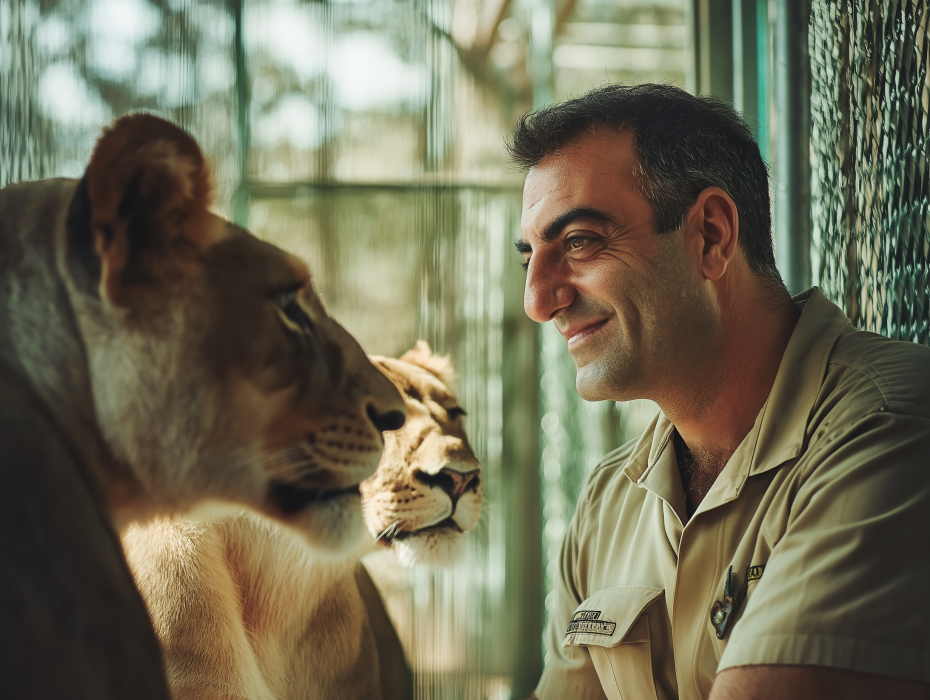
Weeks later, Tom visited them in the quiet vet wing. Sahara lay curled beside Nyla, their breathing steady, eyes half-closed in trust. Outside, the city bustled on, already chasing new headlines. But for Tom, the memory endured: the night mercy triumphed, and a lion reminded humans of what family truly meant.
